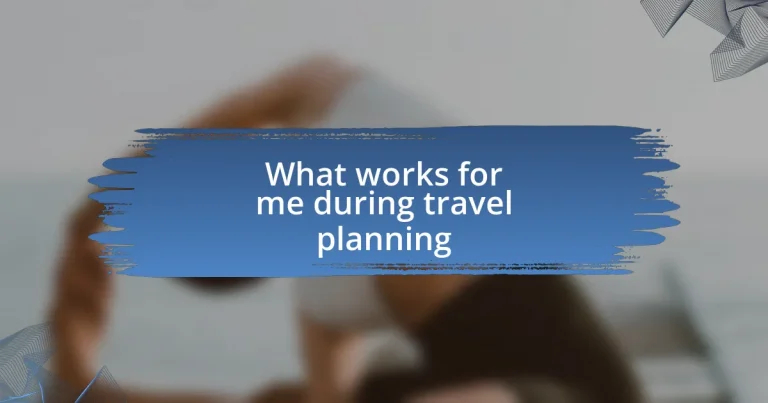Key takeaways:
- Understanding personal travel preferences involves balancing culture and comfort, enhancing the overall travel experience.
- Creating a travel budget is essential for enjoyable trips, helping to allocate funds for transportation, accommodation, food, and activities.
- Effective research on destinations, including exploring personal experiences and hidden gems, enriches the travel planning process.
- Flexibility in itineraries allows for spontaneous discoveries and local recommendations, leading to memorable experiences during trips.

Understanding personal travel preferences
Understanding personal travel preferences is a journey in itself. Reflecting on my past trips, I’ve noticed that I thrive in places that offer a mix of adventure and relaxation. For example, visiting a bustling market in the morning and lounging on a serene beach in the afternoon speaks to my love for varied experiences.
When I think about what drives my travel choices, I can’t help but wonder: do you prioritize culture over comfort or vice versa? Personally, immersing myself in local traditions makes my travels memorable. I still remember sipping tea with a local family in Morocco, and that connection to culture far outshines the luxury of a five-star hotel.
Understanding my travel preferences took time and reflection. I have grappled with choices between nature retreats and urban escapades. Ultimately, I realized that it’s about balancing what I enjoy the most and what rejuvenates me. This self-awareness not only enriches my travels but also makes planning feel more like an enjoyable adventure rather than a chore.

Creating a travel budget
Creating a travel budget can often feel overwhelming, but I see it as a crucial step that makes the whole experience more enjoyable. I vividly recall my first international trip. I went in with no clear budget, and unexpectedly found myself eating instant noodles every night because I had overspent on souvenirs. Now, I carefully outline my expenses to avoid that fate again.
Here’s how I break down my budget:
- Transportation: Plan for flights, trains, or car rentals. I always compare prices and book early for better deals.
- Accommodation: I look for options that fit my comfort level and budget, whether it’s a cozy Airbnb or a well-rated hostel.
- Food: I set aside a daily allowance, trying to strike a balance between street food and a few nice dinners.
- Activities: Research attractions and their costs ahead of time, allowing for a mix of paid and free options.
- Emergency Fund: I always add a little extra for unexpected expenses; it gives me peace of mind during my trip.
Establishing a budget helps me travel more freely. The time I decided to splurge on a cooking class in Italy was certainly worth it. Not only did I learn how to make pasta from scratch, but it also enhanced my appreciation for local cuisine without breaking my budget. This is the kind of experience that makes careful planning so rewarding!
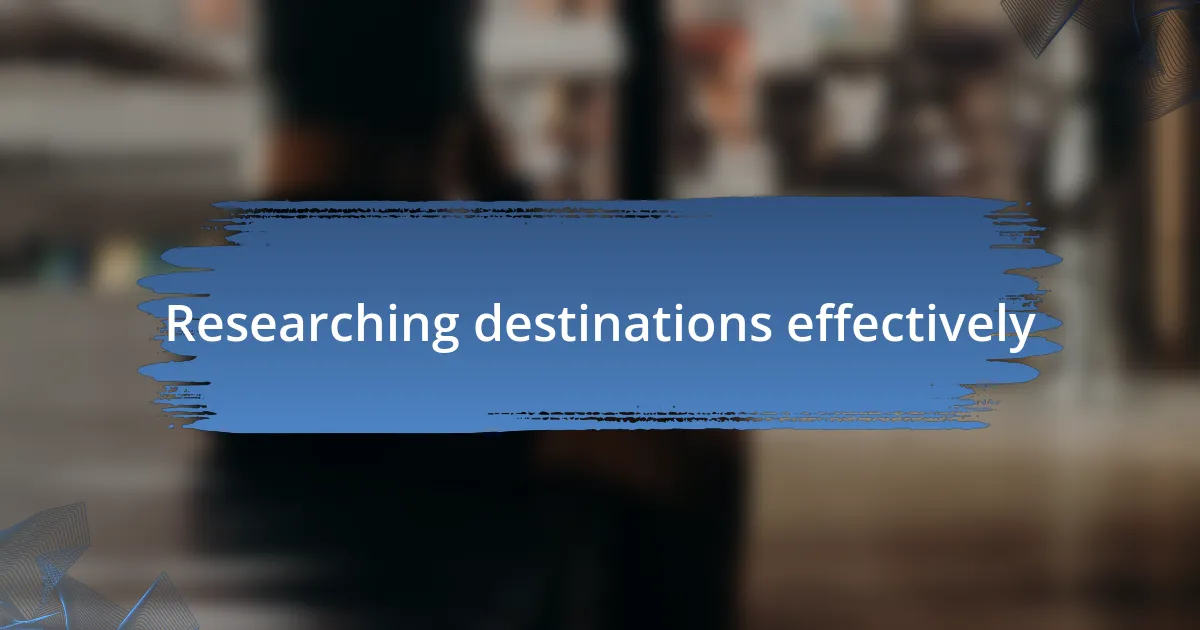
Researching destinations effectively
Researching destinations effectively is a vital part of travel planning. When I set my sights on a new place, I dive deep into local customs, cuisine, and even the nuances of the land’s geography. For me, reading travel blogs or watching vlogs from those who’ve visited is an inspiring way to learn and imagine my future experiences. I remember planning a trip to Japan; the more I learned about its culture through firsthand accounts, the more excited I became to immerse myself.
I also believe in comparing multiple sources for research. Websites like TripAdvisor can give you a broad view, but personal experiences shared on forums or blogs often unveil hidden gems. During my visit to Peru, I found an off-the-beaten-path hiking trail that was only mentioned in a small travel forum. That trek led me to stunning views and a sense of adventure that the more popular spots simply couldn’t provide.
It’s worth noting that keeping an open mind and being flexible can make your research efforts even richer. While preparing for a road trip through the American Southwest, I discovered a quirky roadside attraction that wasn’t on my original itinerary. It turned out to be one of the highlights of my journey. Each destination I explore opens up a world of possibilities, and thorough research lays the groundwork for unforgettable memories.
| Research Method | Pros |
|---|---|
| Travel Blogs/Vlogs | Personal insights and experiences from real travelers |
| TripAdvisor | Broad reviews and ratings for attractions |
| Travel Forums | Hidden gems and off-the-beaten-path suggestions |
| Guidebooks | Comprehensive information and tips |
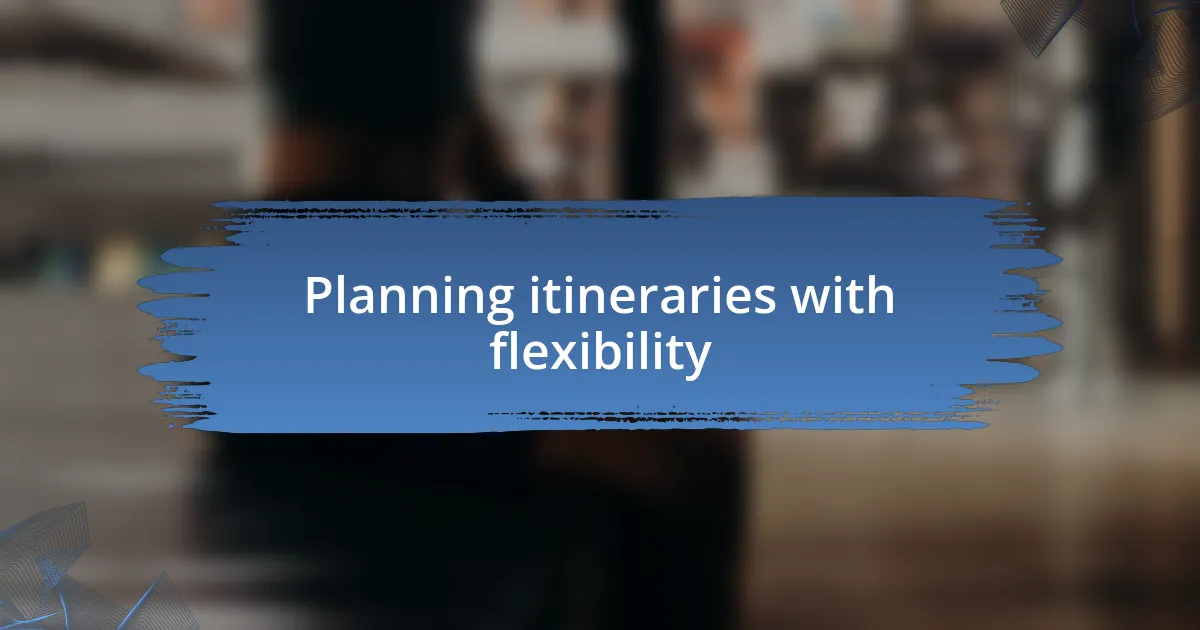
Planning itineraries with flexibility
When it comes to planning itineraries, I’ve learned that flexibility can transform the entire travel experience. While I always start with a rough outline of must-see attractions, I leave room for spontaneity. For instance, while I was road-tripping along the coast of Amalfi, I stumbled upon a small beach that wasn’t mentioned in any guidebook. The crystal-clear waters and serene atmosphere turned out to be the highlight of the trip. Have you ever found something amazing by leaving your plan open? It’s those unplanned moments that often make travel unforgettable.
Another aspect of flexibility in itineraries is the ability to adapt based on local recommendations. I remember being in Barcelona, excited about visiting major landmarks like Sagrada Familia. However, a friendly local suggested a lesser-known tapas bar that changed the way I experienced the city. I let my schedule shift to accommodate this suggestion, and it led to delightful culinary adventures I hadn’t anticipated. Isn’t it fascinating how a new perspective can reshape your plans?
I also recommend not cramming too much into each day, which can create unnecessary stress. I find that leaving breaks in my itinerary makes a huge difference. When I took a trip to Iceland, I intentionally included downtime in my schedule, allowing me to enjoy moments of reflection while gazing at waterfalls. Those moments of pause not only recharge my energy but also provide space for unexpected discoveries, like meeting fellow travelers or finding a local café. Who knows what you might uncover when you give yourself room to breathe?
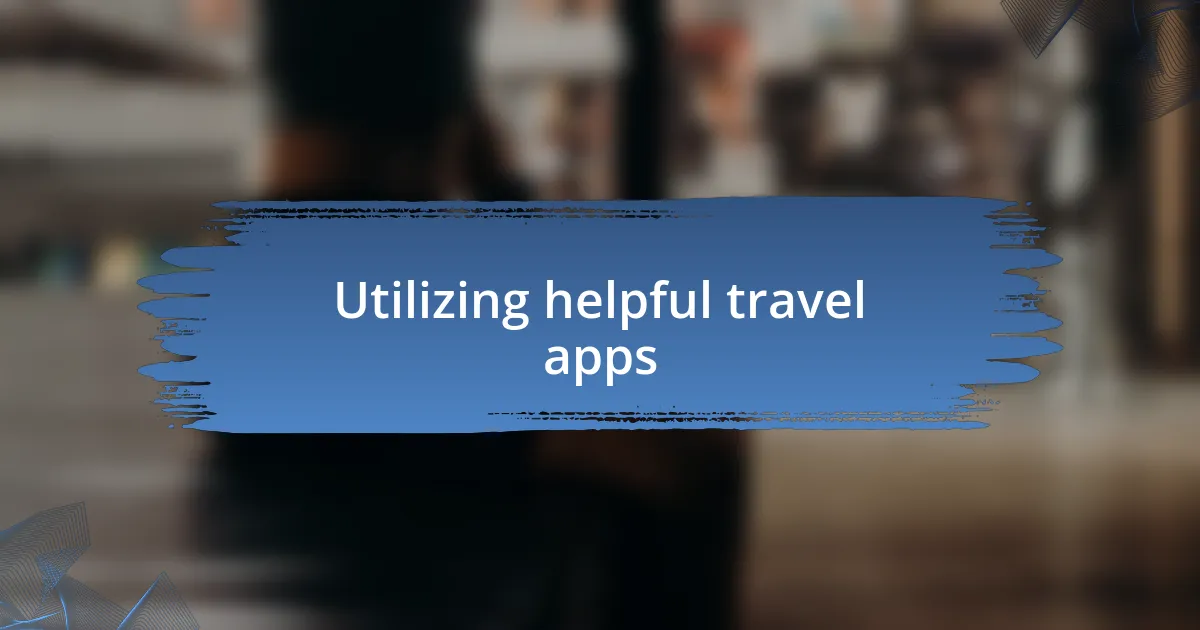
Utilizing helpful travel apps
Travel apps have become indispensable tools for me during the planning process. For instance, when preparing for my trip to Japan, I discovered an app that integrated transportation schedules with local attractions. This feature allowed me to map out my days efficiently, ensuring I wasn’t wasting precious time figuring out how to get from one place to another. Have you ever felt overwhelmed by transportation logistics? Those apps provided clarity and peace of mind.
One of my favorites is a budgeting app that tracks expenses in real-time. On a recent trip to Thailand, I used it diligently and was pleasantly surprised at how it helped me stay on budget while still indulging in local cuisine and activities. I remember savoring a delicious street food dish without the anxiety of overspending because I could see my financials at a glance. Isn’t it incredible how managing finances can enhance your travel experience, allowing for more enjoyment?
Lastly, I can’t overlook the social aspect of travel apps. I’ve often connected with fellow travelers through platforms that allow sharing tips, itineraries, and even meet-up suggestions. During a trip to New York City, I coordinated a spontaneous coffee meeting with someone I met through an app. We exchanged travel stories, and it turned into a memorable afternoon exploring hidden gems together. Doesn’t it make you feel more connected to the world when you find fellowship in unfamiliar places?
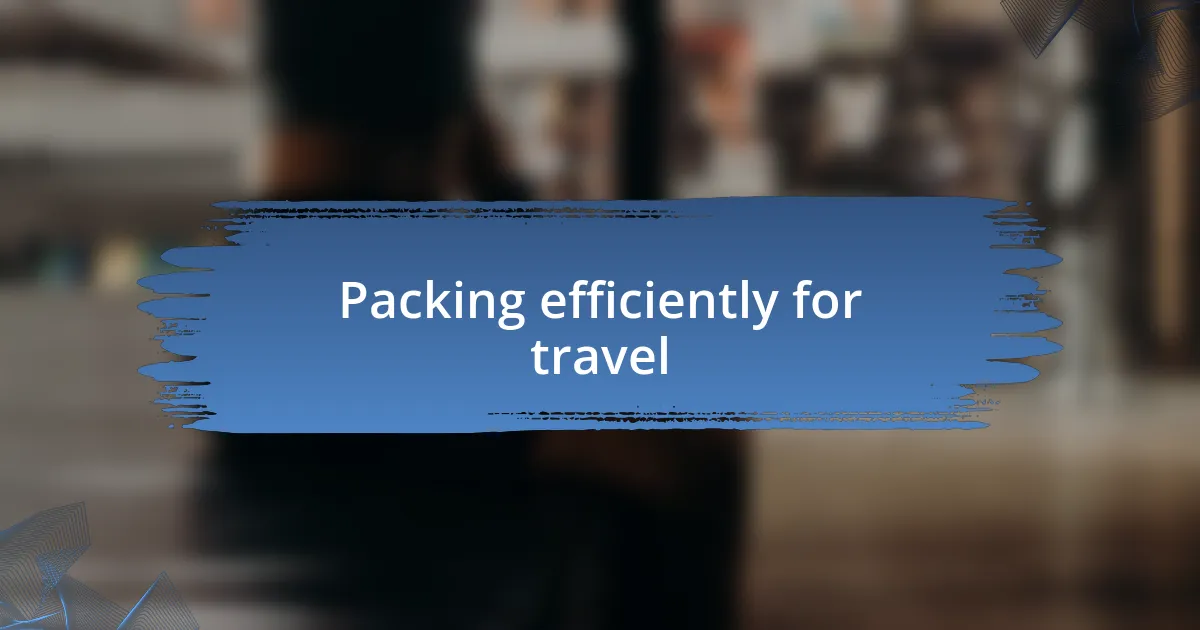
Packing efficiently for travel
Packing efficiently is an art that I’ve honed over the years, transforming the often chaotic process into a smooth operation. One strategy I swear by is the use of packing cubes. During my recent trip to Italy, I organized my clothes by type: tops in one cube and bottoms in another. When I arrived at my destination, it felt like I was unpacking a mini wardrobe instead of a jumbled mess. Doesn’t it just make sense to have that level of organization when you’re navigating new environments?
Another trick I employ is the rolling method for clothing. Not only does it save space, but it also minimizes wrinkles, which is a huge bonus after a long flight. I remember packing for a week-long adventure in Costa Rica and fitting everything I needed into carry-on luggage. When I finally zipped it up, I felt a wave of relief wash over me—no checked bags and no waiting at the carousel. Have you ever experienced that freedom of traveling light?
Lastly, I always make a checklist tailored to my itinerary. For instance, before a hiking trip in the Rockies, I jotted down essential gear like water shoes and insect repellent. Checking items off created a sense of accomplishment and ensured I didn’t forget anything crucial. How do you normally keep track of what to take? I’ve found that this small step significantly enhances my travel experience, leaving more room for spontaneous adventures.
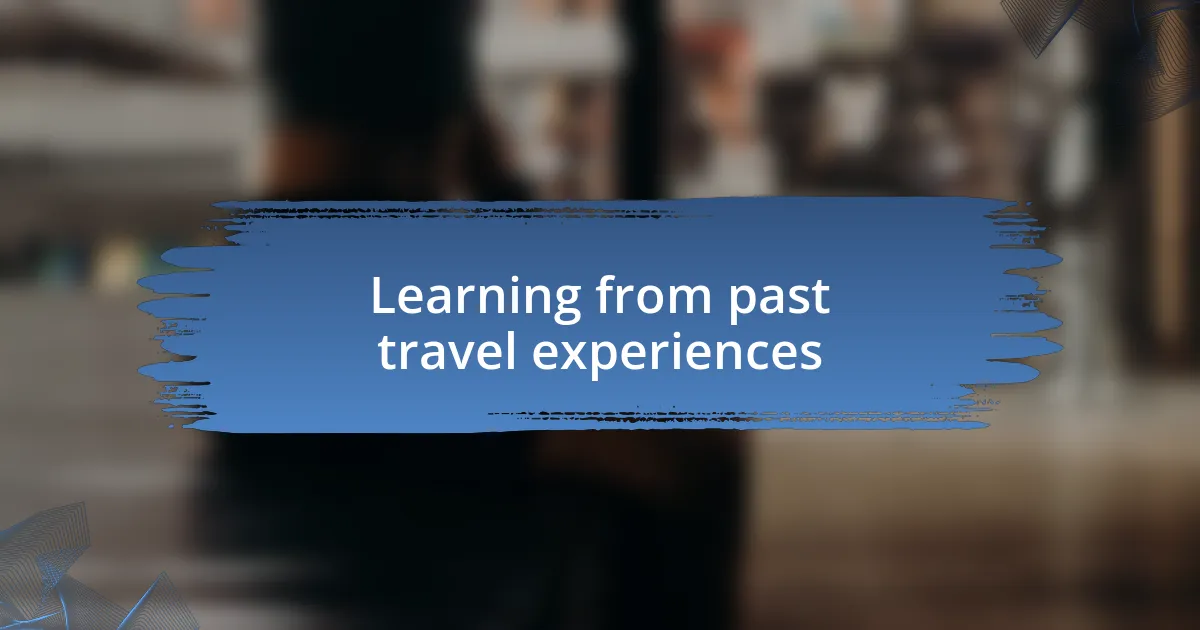
Learning from past travel experiences
Reflecting on my past travel experiences has truly shaped the way I plan future trips. For instance, after a rather rushed visit to Paris, where I missed several key attractions, I learned the importance of pacing my itinerary. Isn’t it frustrating to return home and realize you barely scratched the surface of a destination? Now, I prioritize key experiences and leave flexibility for spontaneous moments, ensuring I truly soak in the local culture.
One travel faux pas I’ll never forget was an overly ambitious plan during a road trip through the Pacific Northwest. I packed my days too tightly, which resulted in missed opportunities like exploring quaint coffee shops or watching a breathtaking sunset. That trip taught me that sometimes it’s better to savor fewer destinations than to rush through many. Have you ever felt that urge to maximize your time, only to end up feeling stressed instead of exhilarated? I now aim for a balance that makes exploring enjoyable, rather than overwhelming.
I also find that keeping a travel journal helps me learn even more from my adventures. During my last trip to Japan, I jotted down not just what I saw, but how I felt in those moments. This practice has illuminated trends in my travel preferences over time and exposed the joys of unexpected discoveries. Isn’t it fascinating to look back and see how your travel style evolves? Documenting these insights has profoundly enriched my travel planning by helping me align future trips with what I truly value.
